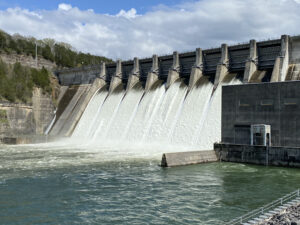Push for greater transparency

Center Hill Dam on the Caney Fork River in Lancaster, Tenn., discharges water from its spillways April 8, 2021. (U.S. Army Corps of Engineers Photo by Leon Roberts)
A recent Florida Politics story highlighted the Associated Press’ review of federal records and data surrounding dam inundation probabilities and the flood danger associated with current federal policy.
In many cases, homeowners who have homes in flood-prone areas will pay more for flood insurance or be left unaware of danger posed by dams built upstream. Much of the problem is the lack of coordination between FEMA, the Army Corps of Engineers, the Federal Energy Regulatory Commission (FERC), and others and it is not uncommon for one federal agency to not talk to another or confer with each other…at all! And as if our readers needed a reminder, floods have caused about $108 billion of damage in the U.S. since 2000, according to FEMA.
The data review spans over 20 years and a California emergency official warned of the problem as recently as 2020, at an invitation-only event hosted by FEMA’s National Dam Safety Board.
Let’s start with FEMA’s Community Rating System (CRS). Communities that chart all the homes, businesses and critical facilities endangered by a potential dam failure and warn people of their risk get points that can reduce the cost of flood insurance for their citizens. But trying to gather the dam inundation data can be impossible when, for example, the Bureau of Reclamation, citing security risks for would-be saboteurs, restricts the release of it for hundreds of dams that it owns or regulates.
FEMA is accepting public comment through Sept. 9 on potential revisions to its Community Rating System but “conflicting federal policies regarding dam flood zones were unfair to communities trying to get better insurance discounts for their residents,” according to a large city’s floodplain manager.
Despite the security concerns post Sept. 11, 2001 that dams can become targets, FEMA says it is important for communities to have access to dam-failure inundation maps in order to warn residents in harm’s way.
FERC continues to categorize dam inundation maps as critical infrastructure information. Those consumers who do receive FERC’s dam data sign a Non-Disclosure Agreement (NDA), but there are no NDA police if the information is shared. The Bureau of Reclamation has the same NDA process but is working to become more transparent. Lastly, the Army Corps of Engineers has begun posting its dam information and FEMA says their dam transparency will begin in 2026.
LMA Newsletter of 9-3-24

